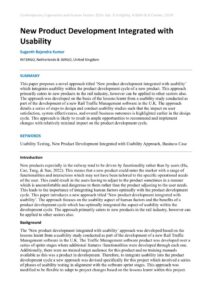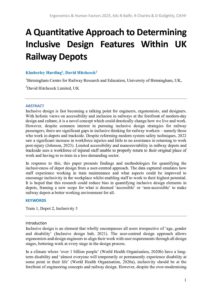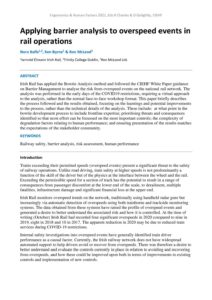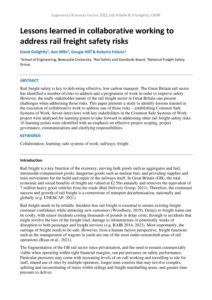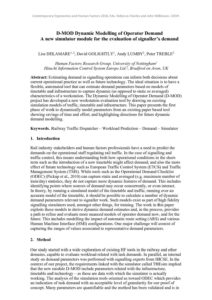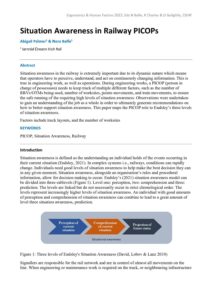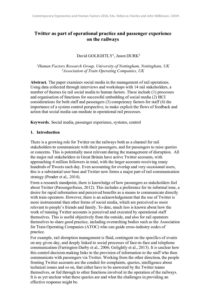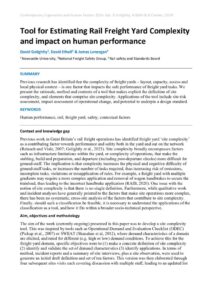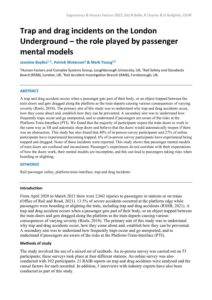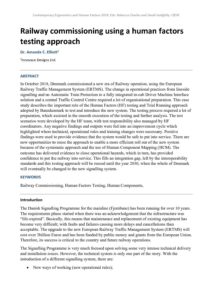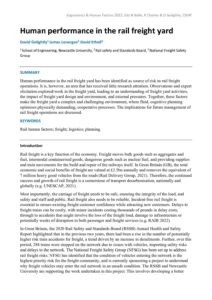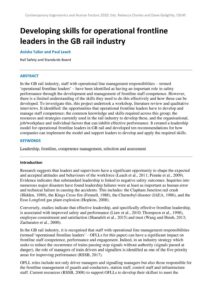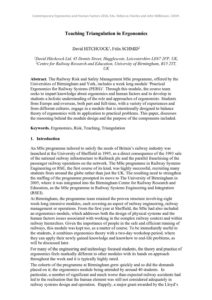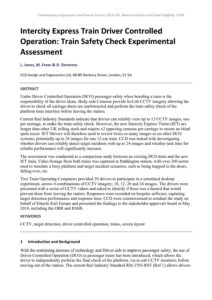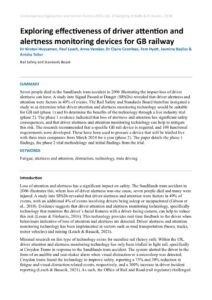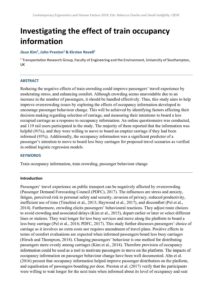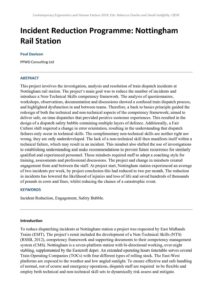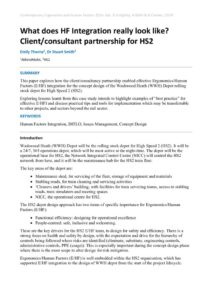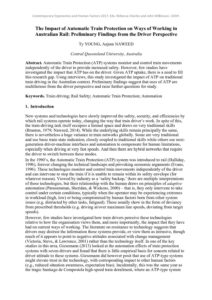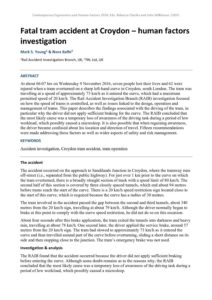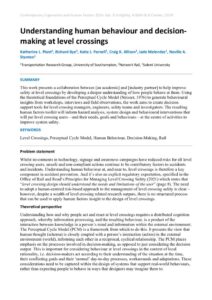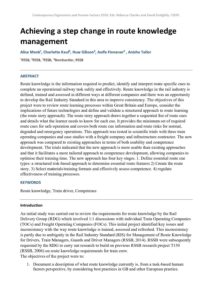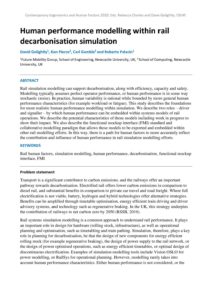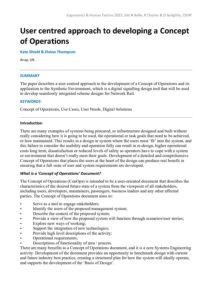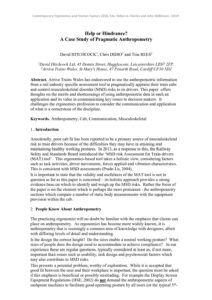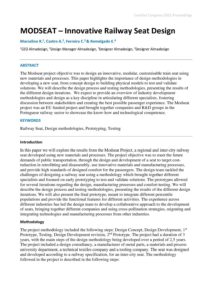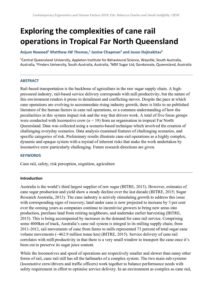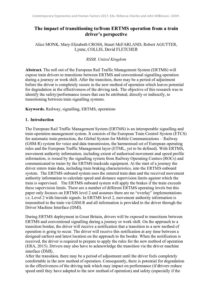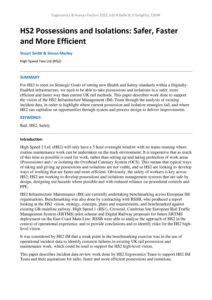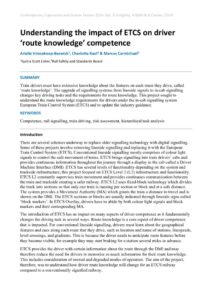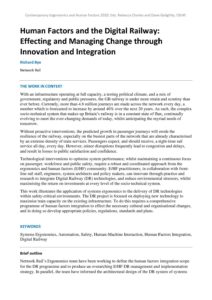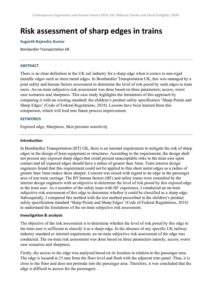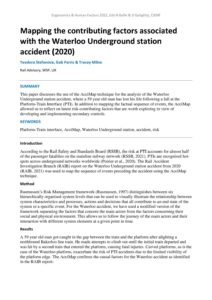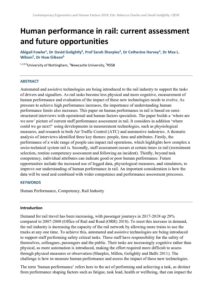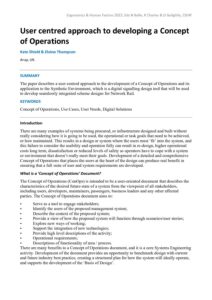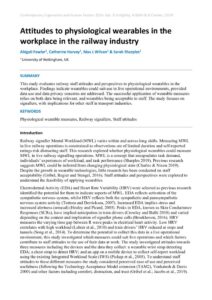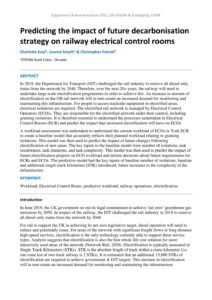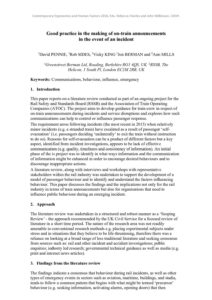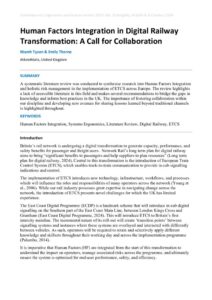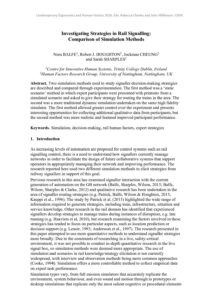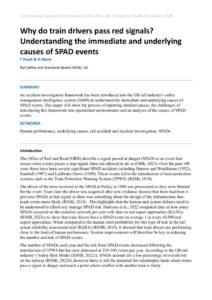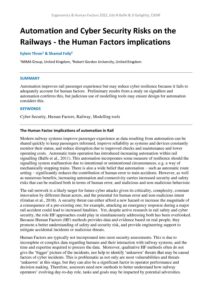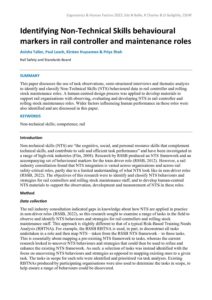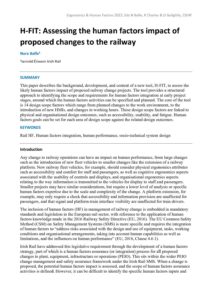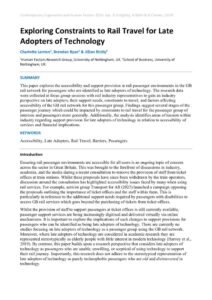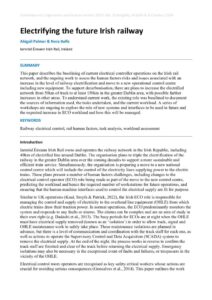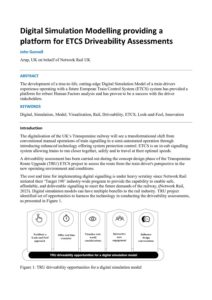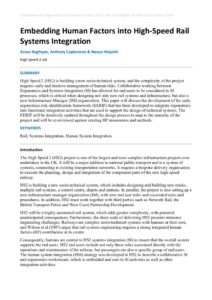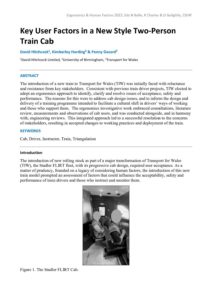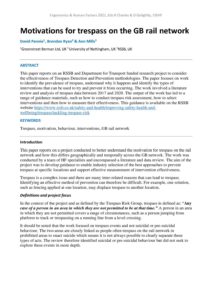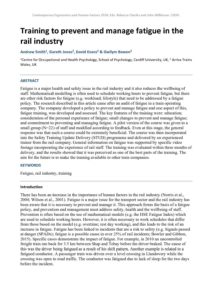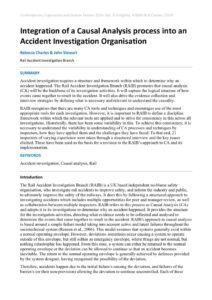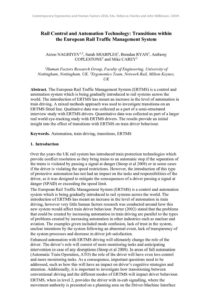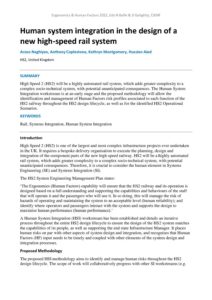Rail
New Product Development Integrated with Usability
| Document | Author Suganth Rajendra Kumar |
| Abstract This paper proposes a novel approach titled ‘New product development integrated with usability’ which integrates usability within the product development cycle of a new product. This approach primarily caters to new products in the rail industry, however can be applied to other sectors also. The approach was developed on the basis of the lessons learnt from a usability study conducted as part of the development of a new Rail Traffic Management software in the U.K. The approach details a series of steps to design and conduct usability studies such that the impact on user satisfaction, system effectiveness, and overall business outcomes is highlighted earlier in the design cycle. This approach is likely to result in ample opportunities to recommend and implement changes with relatively minimal impact on the product development cycle. |
A Quantitative Approach to Determining Inclusive Design Features Within UK Railway Depots
| Document | Author Kimberley Harding & David Hitchcock |
| Abstract Inclusive design is fast becoming a talking point for engineers, ergonomists, and designers. With holistic views on accessibility and inclusion in railways at the forefront of modern-day design and culture, it is a novel concept which could drastically change how we live and work. However, despite common interest in pursuing inclusive design strategies for railway passengers, there are significant gaps in inclusive thinking for railway workers – namely those who work in depots and trackside. Despite reforming modern system safety techniques, 2022 saw a significant increase in workforce injuries and little to no assistance in returning to work post-injury (Johnson, 2023). Limited accessibility and manoeuvrability in railway depots and trackside sees a workforce of injured staff unable to properly return to their original place of work and having to re-train in a less demanding sector. In response to this, this paper presents findings and methodologies for quantifying the inclusiveness of depot design from a user-centred approach. The data captured emulates how staff experience working in train maintenance and what aspects could be improved to encourage inclusivity in the workplace whilst enabling staff to work to their highest potential. It is hoped that this research could reduce bias in quantifying inclusive design elements in depots, framing a new scope for what is deemed ‘accessible’ or ‘non-accessible’ to make railway depots a better working environment for all. |
Applying barrier analysis to overspeed events in rail operations
| Document | Author Nora Balfe, Ken Byrne & Ron McLeod |
| Abstract Irish Rail has applied the Bowtie Analysis method and followed the CIEHF White Paper guidance on Barrier Management to analyse the risk from overspeed events on the national rail network. The analysis was performed in the early days of the COVID19 restrictions, requiring a virtual approach to the analysis, rather than the normal face-to-face workshop format. This paper briefly describes the process followed and the results obtained, focusing on the learnings and potential improvements to the process, rather than the technical details of the analysis. These include: at what point in the bowtie development process to include frontline expertise; prioritising threats and consequences identified so that most effort can be focussed on the most important controls; the complexity of degradation factors relating to human performance; and ensuring presentation of the results matches the expectations of the stakeholder community. |
Lessons learned in collaborative working to address rail freight safety risks
| Document | Author David Golightly, Ann Mills, Dougie Hill & Roberto Palacin |
| Abstract Rail freight safety is key to delivering effective, low carbon transport. The Great Britain rail sector has identified a number of risks to address and a programme of work in order to improve safety. However, the multi-stakeholder nature of the rail freight sector in Great Britain can present challenges when addressing those risks. This paper presents a study to identify lessons learned in the execution of collaborative work to address one of those risks – establishing Common Safe Systems of Work. Seven interviews with key stakeholders in the Common Safe Systems of Work project were analysed for learning points to take forward in addressing other rail freight safety risks. 16 learning points were identified with an emphasis on effective project scoping, project governance, communications and clarifying responsibilities. |
D-MOD Dynamic Modelling of Operator Demand – A new simulator module for the evaluation of signaller’s demand
| Document | Author Lise DELAMARE, David GOLIGHTLY, Andy LUMBY, Peter TREBLE |
| Abstract Estimating demand in signalling operations can inform both decisions about current operational practice as well as future technology. The ideal situation is to have a flexible, automated tool that can estimate demand parameters based on models of timetable and infrastructure to capture dynamic (as opposed to static or averaged) characteristics of a workstation. The Dynamic Modelling of Operator Demand (D-MOD) project has developed a new workstation evaluation tool by drawing on existing simulation models of traffic, timetable and infrastructure. This paper presents the first phase of work to dynamically model parameters from an existing paper based tool showing savings of time and effort, and highlighting directions for future dynamic demand modelling. |
Situation Awareness in Railway PICOPs
| Document | Author Abigail Palmer & Nora Balfe |
| Abstract Situation awareness in the railway is extremely important due to its dynamic nature which means that operators have to perceive, understand, and act on continuously changing information. This is true in engineering work, as well as operations. During engineering works, a PICOP (person in charge of possession) needs to keep track of multiple different factors, such as the number of RRVs/OTMs being used, number of worksites, points movements, and train movements, to ensure the safe running of the requiring high levels of situation awareness. Observations were undertaken to gain an understanding of the job as a whole in order to ultimately generate recommendations on how to better support situation awareness. This paper maps the PICOP role to Endsley’s three levels of situation awareness. Factors include track layouts, and the number of worksites |
Twitter as part of operational practice and passenger experience on the railways
| Document | Author David GOLIGHTLY, Jason DURK |
| Abstract The paper examines social media in the management of rail operations. Using data collected through interviews and workshops with 14 rail stakeholders, a number of themes tie rail social media to human factors. These include (1) processes and organisation of functions for successful embedding of social media (2) HCI considerations for both staff and passengers (3) competency factors for staff (4) the importance of a system control perspective, to make explicit the flows of feedback and action that social media can mediate in operational rail processes. |
Tool for Estimating Rail Freight Yard Complexity and impact on human performance
| Document | Author David Golightly , David Ethell & James Lonergan |
| Abstract Previous research has identified that the complexity of freight yards – layout, capacity, access and local physical context – is one factor that impacts the safe performance of freight yard tasks. We present the rationale, method and contents of a tool that makes explicit the definition of site complexity, and elements that comprise site complexity. Applications of the tool include site risk assessment, impact assessment of operational change, and potential to underpin a design standard. |
Trap and drag incidents on the London Underground – the role played by passenger mental models
| Document | Author Jasmine Bayliss, Patrick Waterson & Mark Young |
| Abstract A trap and drag accident occurs when a passenger gets part of their body, or an object trapped between the train doors and gets dragged along the platform as the train departs causing various consequences of varying severity (Roels, 2018). The primary aim of this study was to understand why trap and drag accidents occur, how they come about and, establish how they can be prevented. A secondary aim was to understand how frequently traps occur and go unreported, and to understand if passengers are aware of the risks at the Platform-Train-Interface (PTI). We found that the majority of participants expect the train doors to work in the same way as lift and automatic shop doors and believe that the doors would automatically reopen if there was an obstruction. This study has also found that 40% of in-person survey participants and 27% of online participants have experienced becoming trapped. 6% of in-person survey participants have experienced being trapped and dragged. None of these incidents were reported. This study shows that passenger mental models of train doors are confused and inconsistent. Passenger’s experiences do not correlate with their expectations of how the doors work, their mental models are incomplete, and this can lead to passengers taking risks when boarding or alighting. |
Railway commissioning using a human factors testing approach
| Document | Author Dr. Amanda C. Elliott |
| Abstract In October 2018, Denmark commissioned a new era of Railway operation, using the European Railway Traffic Management System (ERTMS). The change in operational practices from lineside signalling and no Automatic Train Protection to a fully integrated in-cab Driver Machine Interface solution and a central Traffic Control Centre required a lot of organisational preparation. This case study describes the important role of the Human Factors (HF) testing and Trial Running approach adopted by Banedanmark to test and introduce the new system. The testing process required a lot of preparation, which assisted in the smooth execution of the testing and further analysis. The test scenarios were developed by the HF team, with test responsibility also managed by HF coordinators. Any negative findings and outputs were fed into an improvement cycle which highlighted where technical, operational rules and training changes were necessary. Positive findings were used to provide evidence that the system would be safe to put into service. There are now opportunities to reuse the approach to enable a more efficient roll out of the new system because of the systematic approach and the use of Human Component Mapping (HCM). The outcome has delivered evidence to close operational hazards, which in turn, has provided confidence to put the railway into service. This fills an integration gap, left by the interoperability standards and this testing approach will be reused until the year 2030, when the whole of Denmark will eventually be changed to the new signalling system. |
Human performance in the rail freight yard
| Document | Author David Golightly, James Lonergan & David Ethell |
| Abstract Human performance in the rail freight yard has been identified as source of risk to rail freight operations. It is, however, an area that has received little research attention. Observations and expert elicitation explored work in the freight yard, leading to an understanding of freight yard activities, the impact of freight yard design and environment, and external pressures. Together, these factors make the freight yard a complex and challenging environment, where fluid, cognitive planning optimises physically demanding, cooperative processes. The implications for future management of rail freight operations are discussed. |
Developing skills for operational frontline leaders in the GB rail industry
| Document | Author Anisha Tailor and Paul Leach |
| Abstract In the GB rail industry, staff with operational line management responsibilities – termed ‘operational frontline leaders’ – have been identified as having an important role in safety performance through the development and management of frontline staff competence. However, there is a limited understanding of the skills they need to do this effectively and how these can be developed. To investigate this, this project undertook a workshop, literature review and qualitative interviews. It identified: the opportunities that operational frontline leaders have to develop and manage staff competence; the common knowledge and skills required across this group; the resources and strategies currently used in the rail industry to develop these, and the organisational, job/workplace and individual factors that can inhibit effective performance. It created a leadership model for operational frontline leaders in GB rail and developed ten recommendations for how companies can implement the model and support leaders to develop and apply the required skills. |
Teaching Triangulation in Ergonomics
| Document | Author David HITCHCOCK, Felix SCHMID |
| Abstract The Railway Risk and Safety Management MSc programme, offered by the Universities of Birmingham and York, includes a week long module ‘Practical Ergonomics for Railway Systems (PERS)’. Through this module, the course team seeks to impart knowledge about ergonomics and human factors and to develop in students a holistic understanding of the role and approaches of ergonomists. Students from Europe and overseas, both part and full-time, with a variety of experiences and from different cultures, engage in a module that is intentionally designed to balance theory of ergonomics with its application to practical problems. This paper, discusses the reasoning behind the module design and the purpose of the components included. |
Intercity Express Train Driver Controlled Operation: Train Safety Check Experimental Assessment
| Document | Author L. Jones, M. Freer & D. Simmons |
| Abstract Under Driver Controlled Operation (DCO) passenger safety when boarding a train is the responsibility of the driver alone. Body-side Cameras provide In-Cab CCTV imagery allowing the driver to check all carriage doors are unobstructed and perform the train safety check of the platform train interface before leaving the station. Current Rail Industry Standards indicate that drivers can reliably view up to 12 CCTV images, one per carriage, to make the train safety check. However, the new Intercity Express Trains (IET) are longer than other UK rolling stock and require x2 opposing cameras per carriage to ensure no blind spots occur. IET Drivers will therefore need to review twice as many images as on other DCO systems; potentially up to 24 images for one 12-car train. CCD was tasked with investigating whether drivers can reliably detect target incidents with up to 24 images and whether task time for reliable performance will significantly increase. The assessment was conducted as a comparison study between an existing DCO train and the new IET train. Video footage from both trains was captured at Paddington station, with over 200 actors used to simulate a busy platform and target incident scenarios, such as being trapped in the doors, falling over, etc. Two Train Operating Companies provided 39 drivers to participate in a simulated desktop experiment, across 4 combinations of CCTV imagery; 10, 12, 20 and 24 images. The drivers were presented with a series of CCTV videos and asked to identify if there was a hazard that would prevent them from leaving the station. Responses were recorded on bespoke software, capturing target detection performance and response time. CCD were commissioned to conduct the study on behalf of Hitachi Rail Europe and presented the findings to the stakeholder approvals board in May 2018, including the ORR and RSSB. |
Exploring effectiveness of driver attention and alertness monitoring devices for GB railway
| Document | Author Dr Kirsten Huysamen, Paul Leach, Anna Vereker, Dr Claire Coombes, Tom Hyat, Jasmine Bayliss & Anisha Tailor |
| Abstract Seven people died in the Sandilands tram accident in 2006 illustrating the impact loss of driver alertness can have. A study into Signal Passed at Danger (SPADs) revealed that driver alertness and attention were factors in 49% of events. The Rail Safety and Standards Board therefore instigated a study to a) determine what driver attention and alertness monitoring technology would be suitable for GB rail (phase 1) and b) determine the benefits of the technology through a live industry trial (phase 2). The phase 1 evidence indicated that loss of alertness and attention has significant safety consequences, and that driver alertness and attention monitoring technology can help to mitigate this risk. The research recommended that a specific GB rail device is required, and 108 functional requirements were developed. These have been used to procure a device that will be trialled live with three train companies from March 2024 for a year (phase 2). The paper details the phase 1 findings, the phase 2 trial methodology and initial findings from the trial. |
Design induced non-compliance: influences on pedestrian and cyclist behaviour at level crossings
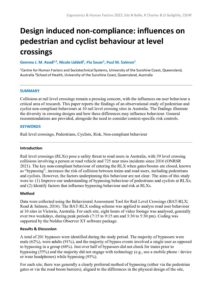
| Document
Insert here |
Author Gemma J. M. Read, Nicole Liddell, Pia Sauer & Paul M. Salmon |
| Abstract Collisions at rail level crossings remain a pressing concern, with the influences on user behaviour a critical area of research. This paper reports the findings of an observational study of pedestrian and cyclist non-compliant behaviours at 10 rail level crossing sites in Australia. The findings illustrate the diversity in crossing designs and how these differences may influence behaviour. General recommendations are provided, alongside the need to consider context-specific risk controls. |
Investigating the effect of train occupancy information
| Document | Author Jisun Kim, John Preston & Kirsten Revell |
| Abstract Reducing the negative effects of train crowding could improve passengers’ travel experience by moderating stress, and enhancing comfort. Although crowding seems unavoidable due to an increase in the number of passengers, it should be handled effectively. Thus, this study aims to help improve overcrowding issues by exploring the effects of occupancy information developed to encourage passenger behaviour change. This will be achieved by identifying factors affecting their decision making regarding selection of carriage, and measuring their intentions to board a less occupied carriage as a response to occupancy information. An online questionnaire was conducted, and 119 rail users participated in the study. The majority of them reported that the information was helpful (91%), and they were willing to move to board an emptier carriage if they had been informed (93%). Additionally, the occupancy information was a significant predictor of a passenger’s intention to move to board less busy carriages for proposed travel scenarios as verified in ordinal logistic regression models. |
Incident Reduction Programme: Nottingham Rail Station
| Document | Author Paul Davison |
| Abstract This project involves the investigation, analysis and resolution of train dispatch incidents at Nottingham rail station. The project’s main goal was to reduce the number of incidents and introduce a Non-Technical Skills competency framework. The analysis of questionnaires, workshops, observations, documentation and discussions showed a confused train dispatch process, and highlighted dysfunction in and between teams. Therefore, a back to basics principle guided the redesign of both the technical and non-technical aspects of the competency framework; aimed to deliver safe, on time dispatches that provided positive customer experiences. This resulted in the design of a dispatch safety bubble containing multiple layers of defence. Additionally, a Fair Culture shift required a change in error orientation, resulting in the understanding that dispatch failures only occur in technical skills. The complimentary non-technical skills are neither right nor wrong, they are only underdeveloped. The lack of a non-technical skill then manifests itself within a technical failure, which may result in an incident. This mindset also shifted the use of investigations to establishing understanding and make recommendations to prevent future recurrence for similarly qualified and experienced personnel. These mindsets required staff to adopt a coaching style for training, assessments and professional discussions. The project and change in mindsets created engagement from and between the staff. At project start, Nottingham station experienced an average of two incidents per week, by project conclusion this had reduced to two per month. The reduction in incidents has lowered the likelihood of injuries and loss of life and saved hundreds of thousands of pounds in costs and fines, whilst reducing the chance of a catastrophic event. |
What does HF Integration really look like? Client/consultant partnership for HS2
| Document | Author Emily Thorne, Dr Stuart Smith |
| Abstract This paper explores how the client/consultancy partnership enabled effective Ergonomics/Human Factors (E/HF) integration for the concept design of the Washwood Heath (WWH) Depot rolling stock depot for High Speed 2 (HS2). Exploring lessons learnt from this case study intends to highlight examples of “best practice” for effective E/HFI and discuss practical tips and tools for implementation which may be transferrable to other projects, and sectors beyond the rail sector. |
The Impact of Automatic Train Protection on Ways of Working in Australian Rail: Preliminary Findings from the Driver Perspective
| Document | Author Ty YOUNG, Anjum NAWEED |
| Abstract Automatic Train Protection (ATP) systems monitor and control train movements independently of the driver to provide increased safety. However, few studies have investigated the impact that ATP has on the driver. Given ATP uptake, there is a need to fill this research gap. Using interviews, this study investigated the impact of ATP on traditional train driving in the Australian context. Preliminary findings suggest that uses of ATP are multifarious from the driver perspective and raise further questions for study. |
Fatal tram accident at Croydon – human factors investigation
| Document | Author Mark S. Young & Nora Balfe |
| Abstract At about 06:07 hrs on Wednesday 9 November 2016, seven people lost their lives and 62 were injured when a tram overturned on a sharp left-hand curve in Croydon, south London. The tram was travelling at a speed of approximately 73 km/h as it entered the curve, which had a maximum permitted speed of 20 km/h. The Rail Accident Investigation Branch (RAIB) investigation focused on how the speed of trams is controlled, as well as issues linked to the design, operation and management of trams. This paper describes the findings associated with the driving of the tram, in particular why the driver did not apply sufficient braking for the curve. The RAIB concluded that the most likely cause was a temporary loss of awareness of the driving task during a period of low workload, which possibly caused a microsleep. It is also possible that when regaining awareness, the driver became confused about his location and direction of travel. Fifteen recommendations were made addressing these factors as well as wider aspects of safety and risk management. |
Understanding human behaviour and decision-making at level crossing
| Document | Author Katherine L. Plant, Richard Bye, Katie J. Parnell, Craig K. Allison, Jade Melendez, Neville A. Stanton |
| Abstract This work presents a collaboration between [an academic] and [industry partner] to help improve safety at level crossings by developing a deeper understanding of how people behave at them. Using the theoretical foundations of the Perceptual Cycle Model (Neisser, 1976) to generate behavioural insights from workshops, interviews and field observations, the work aims to create decision support tools for level crossing managers, engineers, safety teams and investigators. The resulting human factors toolkit will inform hazard analysis, system design and behavioural interventions that will put level crossing users—and their needs, goals and behaviours—at the centre of activities to improve system safety. |
Achieving a step change in route knowledge management
| Document | Author Alice Monk, Charlotte Kaul, Huw Gibson, Aoife Finneran, Anisha Tailor |
| Abstract Route knowledge is the information required to predict, identify and interpret route specific cues to complete an operational railway task safely and effectively. Route knowledge in the rail industry is defined, trained and assessed in different ways at different companies and there was an opportunity to develop the Rail Industry Standard in this area to improve consistency. The objectives of this project were to review route learning processes within Great Britain and Europe, consider the implications of future technologies and define and validate a structured approach to route learning (the route story approach). The route story approach draws together a sequential list of route cues and details what the learner needs to know for each cue. It provides the minimum set of required route cues for safe operation and covers both route cue information and route risks for normal, degraded and emergency operations. This approach was tested in scientific trials with three train operating companies and case studies with a freight company and infrastructure contractor. The new approach was compared to existing approaches in terms of both usability and competence development. The trials indicated that the new approach is more usable than existing approaches and that it facilitates a more tailored approach to competence development, allowing companies to optimise their training time. The new approach has four key stages. 1. Define essential route cue types: a structured risk-based approach to determine essential route features 2) Create the route story. 3) Select materials/training formats and effectively assess competence. 4) regulate effectiveness of training processes. |
Human performance modelling within rail decarbonisation simulation
| Document | Author David Golightly, Ken Pierce, Carl Gamble and Roberto Palacin |
| Abstract Rail simulation modelling can support decarbonisation, along with efficiency, capacity and safety. Modelling typically assumes perfect operator performance, or human performance is in some way stochastic (noise). In practice, human variability is rational while bounded by more general human performance characteristics (for example workload or fatigue). This study describes the foundations for more realistic human performance modelling within simulation. We describe two roles – driver and signaller – by which human performance can be embedded within systems models of rail operations. We describe the potential characteristics of those models including work in progress to show their impact. We also describe the functional mockup interface (FMI) standard and collaborative modelling paradigm that allows these models to be exported and embedded within other rail modelling efforts. In this way, there is a path for human factors to more accurately reflect the contribution and influence of human performance in rail simulation modelling efforts. |
User centred approach to developing a Concept of Operations
| Document | Author Kate Shield & Elaine Thompson |
| Abstract The paper describes a user centred approach to the development of a Concept of Operations and its application to the Synthetic Environment, which is a digital signalling design tool that will be used to develop seamlessly integrated scheme designs for Network Rail. |
Help or Hindrance? A Case Study of Pragmatic Anthropometry
| Document | Author David HITCHCOCK, Chris DIDIO and Tina REES |
| Abstract Arriva Trains Wales has endeavored to use the anthropometric information from a rail industry specific assessment tool to pragmatically appraise their train cabs and control musculoskeletal disorder (MSD) risks to its drivers. This paper offers thoughts on the merits and shortcomings of using anthropometric data in such an application and its value in communicating key issues to decision makers. It challenges the ergonomics profession to consider the communication and application of what is a cornerstone of the discipline. |
MODSEAT – Innovative Railway Seat Design
Exploring the complexities of cane rail operations in Tropical Far North Queensland
| Document | Author Anjum Naweed, Matthew JW Thomas, Janine Chapman and Jason Hajinakitas |
| Abstract Rail-based transportation is the backbone of agriculture in the raw sugar supply chain. A high-pressured industry, rail-based service delivery corresponds with mill productivity, but the nature of this environment renders it prone to derailment and conflicting moves. Despite the pace at which cane operations are evolving to accommodate rising industry growth, there is little to no published literature of the human factors in cane rail operations, or a common understanding of how the peculiarities in this system impact risk and the way that drivers work. A total of five focus groups were conducted with locomotive crew (n = 19) from an organisation in tropical Far North Queensland. Data was collected using a scenario-based technique which involved the creation of challenging everyday scenarios. Data analysis examined features of challenging scenarios, and specific categories of risk. Preliminary results illustrate cane-rail operations as a highly complex, dynamic and opaque system with a myriad of inherent risks that make the work undertaken by locomotive crew particularly challenging. Future research directions are given. |
The impact of transitioning to/from ERTMS operation from a train driver’s perspective
| Document | Author Alice MONK, Mary-Elizabeth CROSS, Stuart McFARLAND, Robert AGUTTER, Lynne, COLLIS, David FLETCHER |
| Abstract The roll out of the European Rail Traffic Management System (ERTMS) will expose train drivers to transitions between ERTMS and conventional signalling operation during a journey or work shift. After the transition, there may be a period of adjustment before the driver is completely secure in the new method of operation which leaves potential for degradation in the effectiveness of the driving task. The objective of this research was to identify the safety/performance issues that can be attributed, directly or indirectly, to transitioning between train signalling systems. |
HS2 Possessions and Isolations: Safer, Faster and More Efficient
| Document | Author Stuart Smith & Simon Morley |
| Abstract For HS2 to meet its Strategic Goals of setting new Health and Safety standards within a Digitally-Enabled infrastructure, we need to be able to take possessions and isolations in a safer, more efficient and faster way than current UK rail methods. This paper describes work done to support the vision of the HS2 Infrastructure Management (IM) Team through the analysis of existing incident data, in order to highlight where current possession and isolation strategies fail, and where HS2 can capitalise on opportunities through system and process design to deliver improvements. |
Understanding the impact of ETCS on driver ‘route knowledge’ competence
| Document | Author Arielle Vriesekoop-Beswick, Charlotte Kaul & Marcus Carmichael |
| Abstract Train drivers must have extensive knowledge about the features on each route they drive, called ‘route knowledge’. The upgrade of signalling systems from lineside signals to in-cab signalling changes key driving tasks and the requirements for route knowledge. This project sought to understand the route knowledge requirements for drivers under the in-cab signalling system European Train Control System (ETCS) and to update the industry guidance. |
Human factors and the digital railway: Effecting and managing change through innovation and integration
| Document
|
Author Richard Bye |
| Abstract With an infrastructure operating at full capacity, a testing political climate, and a mix of government, regulatory and public pressures, the GB railway is under more strain and scrutiny than ever before. Currently, more than 4.8 million journeys are made across the network every day, a number which is forecasted to increase by around 40% over the next 20 years. As such, the complex sociotechnical system that makes up Britain’s railway is in a constant state of flux, continually evolving to meet the everchanging demands of today, whilst anticipating the myriad needs of tomorrow. Without proactive interventions, the predicted growth in passenger journeys will erode the resilience of the railway, especially on the busiest parts of the network that are already characterised by an extreme density of train services. Passengers expect, and should receive, a right-time rail service all day, every day. However, minor disruptions frequently lead to congestion and delays, and result in losses to public satisfaction and confidence. Technological interventions to optimise system performance, whilst maintaining a continuous focus on passenger, workforce and public safety, require a robust and coordinated approach from the ergonomics and human factors (human factors) community. Human factors practitioners, in collaboration with frontline rail staff, engineers, system architects and policy makers, can innovate through practice and research to integrate digital railway (DR) technologies, and reduce environmental stressors, whilst maximising the return on investments at every level of the sociotechnical system. This work illustrates the application of systems ergonomics to the delivery of DR technologies within safety-critical work environments. The DR project is focused on deploying new technology to maximise train capacity on the existing infrastructure. To do this requires a comprehensive programme of human factors integration to effect the necessary cultural and organisational changes, and in doing so develop appropriate policies, regulations, standards and plans. |
Risk assessment of sharp edges in trains
| Document | Author Suganth Rajendra Kumar |
| Abstract There is no clear definition in the UK rail industry for a sharp edge when it comes to non-rigid metallic edges such as sheet metal edges. In Bombardier Transportation UK, this was managed by a joint safety and human factors assessment to determine the level of risk posed by such edges to train users. An on-train subjective risk assessment was done based on three parameters; access, worst case scenarios and sharpness. This case study highlights the limitations of this approach by comparing it with an existing standard; the children’s product safety specification ‘Sharp Points and Sharp Edges’ (Code of Federal Regulations, 2018). Lessons have been learned from this comparison, which will feed into future process improvement. |
Mapping the contributing factors associated with the Waterloo Underground station accident (2020)
| Document | Author Teodora Stefanova, Gab Parris & Tracey Milne |
| Abstract This paper discusses the use of the AcciMap technique for the analysis of the Waterloo Underground station accident, where a 59 year old man has lost his life following a fall at the Platform-Train Interface (PTI). In addition to mapping the factual sequence of events, the AcciMap allowed us to reflect on latent risk-contributing factors that are worth exploring in view of developing and implementing secondary controls. |
Human performance in rail: current assessment and future opportunities
| Document | Author Abigail Fowler, Dr David Golightly, Prof Sarah Sharples, Dr Catherine Harvey, Dr Max L. Wilson, Dr Huw Gibson |
| Abstract Automated and assistive technologies are being introduced to the rail industry to support the tasks of drivers and signallers. As rail tasks become less physical and more cognitive, measurement of human performance and evaluation of the impact of these new technologies needs to evolve. As pressure to achieve high performance increases, the importance of understanding human performance limits also increases. This paper on human performance in rail is based on semi-structured interviews with operational and human factors specialists. The paper builds a ‘where are we now’ picture of current staff performance assessment in rail. It considers in addition ‘where could we go next?’ using developments in measurement technologies, such as physiological measures, and research in both Air Traffic Control (ATC) and automotive industries. A thematic analysis of interviews identified three key themes: people, time and attributes. Firstly, the performance of a wide range of people can impact rail operations, which highlights how complex a socio-technical system rail is. Secondly, staff assessment occurs at certain times in rail (recruitment selection, routine competency assessment and following an incident). Thirdly, beyond task competency, individual attributes can indicate good or poor human performance. Future opportunities include the increased use of logged data, physiological measures, and simulators, to improve our understanding of human performance in rail. An important consideration is how the data will be used and combined with wider competence and performance assessment processes. |
User centred approach to developing a Concept of Operations
| Document | Author Kate Shield & Elaine Thompson |
| Abstract The paper describes a user centred approach to the development of a Concept of Operations and its application to the Synthetic Environment, which is a digital signalling design tool that will be used to develop seamlessly integrated scheme designs for Network Rail. |
Attitudes to physiological wearables in the workplace in the railway industry
| Document | Author Abigail Fowler, Catherine Harvey, Max L Wilson & Sarah Sharples |
| Abstract This study evaluates railway staff attitudes and perspectives to physiological wearables in the workplace. Findings indicate wearables could suit use in live operational environments, provided data use and data privacy concerns are addressed. The successful application of wearable measures relies on both data being relevant, and wearables being acceptable to staff. The study focuses on signallers, with implications for other staff in transport industries. |
Predicting the impact of future decarbonisation strategy on railway electrical control rooms
| Document | Author Charlotte Kaul, Joanne Smyth & Christopher Patrick |
| Abstract In 2018, the Department for Transport (DfT) challenged the rail industry to remove all diesel-only trains from the network by 2040. Therefore, over the next 20+ years, the railway will need to undertake large scale electrification programmes in order to achieve this. An increase in amount of electrification on the GB rail network will in turn create an increased demand for monitoring and maintaining this infrastructure. For people to access trackside equipment in electrified areas, electrical isolations are required. The electrified rail network is managed by Electrical Control Operators (ECOs). They are responsible for the electrified network under their control, including granting isolations. It is therefore essential to understand the processes undertaken in Electrical Control Rooms (ECR) and predict the impact that increased electrification will have on ECOs. A workload assessment was undertaken to understand the current workload of ECOs in York ECR to create a baseline model that accurately reflects their planned workload relating to granting isolations. This model was then used to predict the impact of future changes following electrification of new areas. The key inputs to the baseline model were number of isolations, task occurrences, task durations, and task complexity. This model was then used to predict the impact of future electrification projects on ECO workload and inform decisions about future requirements for ECRs and ECOs. The predictive model had the key inputs of baseline number of isolations, baseline and additional single-track kilometres (STK) introduced, future increases to the complexity of the infrastructure. |
Good practice in the making of on-train announcements in the event of an incident
| Document | Author David PENNIE, Rob SIDES, Vicky KING, Jon BERMAN and Ann MILLS |
| Abstract |
Human Factors Integration in Digital Railway Transformation: A Call for Collaboration
| Document | Author Niamh Tyson & Emily Thorne |
| Abstract A systematic literature review was conducted to synthesise research into Human Factors Integration and holistic risk management in the implementation of ETCS across Europe. The review highlights a lack of accessible literature in this field and makes several recommendations to bridge the gaps in knowledge and inform best practices in the UK. The importance of fostering collaboration within our discipline and developing new avenues for sharing lessons learned beyond traditional channels is highlighted throughout. |
Investigating Strategies in Rail Signalling: Comparison of Simulation Methods
| Document | Author Nora BALFE, Robert J. HOUGHTON, Jockman CHEUNG and Sarah SHARPLES |
| Abstract Two simulation methods used to study signaller decision-making strategies are described and compared through experimentation. The first method was a ‘static scenario’ method in which expert participants were presented with printouts from a simulated scenario and asked to give their strategy for routing the trains in the area. The second was a more traditional dynamic simulation undertaken on the same high fidelity simulator. The first method allowed greater control over the experiment and presents interesting opportunities for collecting additional qualitative data from participants, but the second method was more realistic and featured improved participant performance. |
Why do train drivers pass red signals? Understanding the immediate and underlying causes of SPAD events
| Document | Author T Hyat & A Monk |
| Abstract An accident investigation framework has been introduced into the GB rail industry's safety management intelligence system (SMIS) to understand the immediate and underlying causes of SPAD events. This paper will show the process of reporting detailed causes, the challenges of introducing this framework into operational environments and an analysis of the causes of SPAD events. |
Automation and Cyber Security Risks on the Railways – the Human Factors implications
| Document | Author Eylem Thron & Shamal Faily |
| Abstract Automation improves rail passenger experience but may reduce cyber resilience because it fails to adequately account for human factors. Preliminary results from a study on signallers and automation confirms this, but judicious use of modelling tools may ensure design for automation considers this. |
Identifying Non-Technical Skills behavioural markers in rail controller and maintenance roles
| Document | Author Anisha Tailor, Paul Leach, Kirsten Huysamen & Priya Shah |
| Abstract This paper discusses the use of task observations, semi-structured interviews and thematic analysis to identify and classify Non-Technical Skills (NTS) behavioural data in rail controller and rolling stock maintenance roles. A human-centred design process was applied to develop materials to support rail organisations with observing, evaluating and developing NTS in rail controller and rolling stock maintenance roles. Wider factors influencing human performance in these roles were also identified and are discussed in this paper. |
H-FIT: Assessing the human factors impact of proposed changes to the railway
| Document | Author Nora Balfe |
| Abstract This paper describes the background, development, and content of a new tool, H-FIT, to assess the likely human factors impact of proposed railway change projects. The tool provides a structured approach to identifying the scope and requirements for human factors integration at early project stages, around which the human factors activities can be specified and planned. The core of the tool is 14 design scope factors which range from planned changes to the work environment, to the introduction of new HMIs, and changes in working hours. These design scope factors are linked to physical and organisational design outcomes, such as accessibility, usability, and fatigue. Human factors goals can be set for each area of design scope against the related design outcomes. |
Exploring Constraints to Rail Travel for Late Adopters of Technology
| Document | Author Charlotte Lenton, Brendan Ryan & Jillian Rickly |
| Abstract This paper explores the accessibility and support provision in rail passenger environments in the GB rail network for passengers who are identified as late adopters of technology. The research data were collected at focus group sessions with rail industry representatives to gain an industry perspective on late adopters, their support needs, constraints to travel, and factors affecting accessibility of the GB rail network for this passenger group. Findings suggest several stages of the passenger journey which could be impacted by constraints to rail travel for the passenger group of interests and passengers more generally. Additionally, the analysis identifies areas of tension within industry regarding support provision for late adopters of technology in relation to accessibility of services and financial implications. |
Electrifying the future Irish railway
| Document | Author Abigail Palmer & Nora Balfe |
| Abstract This paper describes the baselining of current electrical controller operations on the Irish rail network, and the ongoing work to assess the human factors risks and issues associated with an increase in the level of railway electrification and move to a new operational control centre including new equipment. To support decarbonisation, there are plans to increase the electrified network from 50km of track to at least 150km in the greater Dublin area, with possible further increases in other areas. To understand current work, the existing role was baselined to document the sources of information used, the tasks undertaken, and the current workload. A series of workshops are ongoing to explore the role of new systems and interfaces to be used in future and the expected increase in ECO workload and how this will be managed. |
Safety First! Expert Perspectives on Cultural Differences in the Use of Track Warning Systems
| Document | Author Ellice HAHNE, Brendan RYAN and Stuart SMITH |
| Abstract Network Rail, who maintains Britain's rail infrastructure, identified that UK track workers may have an increased incident rate associated with use of warning systems, compared to other countries. This study aimed to identify cultural factors that could influence the design, procurement and use of rail safety equipment. Semi-structured interviews with six experts were conducted. Three of these were subject to a thematic analysis, using information from the other interviews and several industry documents for the purpose of verification. Six main themes were identified: "Organisation", "Mentality", "Training", "Kit", "Choice of warning system", and "Product acceptance process". Recommendations for improvements are proposed. |
Digital Simulation Modelling providing a platform for ETCS Driveability Assessments
| Document | Author John Gunnell |
| Abstract The development of a true-to-life, cutting-edge Digital Simulation Model of a train drivers experience operating with a future European Train Control System (ETCS) system has provided a platform for robust Human Factors analysis and has proven to be a success with the driver stakeholders. |
Embedding Human Factors into High-Speed Rail Systems Integration
| Document | Author Arzoo Naghiyev, Anthony Coplestone & Nassar Majothi |
| Abstract High Speed 2 (HS2) is building a new socio-technical system, and the complexity of the project requires early and iterative management of human risks. Collaborative working between Ergonomics and Systems Integration (SI) has allowed for end users to be considered in SI processes, which is critical when designing not only new rail systems and infrastructure, but also a new Infrastructure Manager (IM) organisation. This paper will discuss the development of the early ergonomics risk identification framework (EERIF) that has been developed to integrate ergonomics into functional integration activities that are used to support the design of technical systems. The EERIF will be iteratively updated throughout the design process to map to the maturity of the project and will be re-reviewed against existing HF taxonomies and methods. |
Key User Factors in a New Style Two-Person Train Cab
| Document | Author David Hitchcock, Kimberley Harding & Penny Gazard |
| Abstract The introduction of a new train to Transport for Wales (TfW) was initially faced with reluctance and resistance from key stakeholders. Consistent with previous train driver projects, TfW elected to adopt an ergonomics approach to identify, clarify and resolve issues of acceptance, safety and performance. The reasons for this were to address cab design issues, and to inform the design and delivery of a training programme intended to facilitate a cultural shift in drivers’ ways of working and those who support them. The ergonomics investigative work embraced consultations, literature review, measurements and observations of cab users, and was conducted alongside, and in harmony with, engineering reviews. This integrated approach led to a successful resolution to the concerns of stakeholders, resulting in accepted changes to working practices and deployment of the train. |
Motivations for trespass on the GB rail network
| Document | Author David Pennie, Brendan Ryan & Ann Mills |
| Abstract This paper reports on an RSSB and Department for Transport funded research project to consider the effectiveness of Trespass Detection and Prevention methodologies. The paper focuses on work to identify the prevalence of trespass, understand why it happens and identify the types of interventions that can be used to try and prevent it from occurring. The work involved a literature review and analysis of trespass data between 2017 and 2020. The output of the work has led to a range of guidance materials, such as how to conduct trespass risk assessment, how to select interventions and then how to measure their effectiveness. This guidance is available on the RSSB website https://www.rssb.co.uk/safety-and-health/improving-safety-health-and-wellbeing/trespass/tackling-trespass-risk |
Training to prevent and manage fatigue in the rail industry
| Document | Author Andrew Smith, Gareth Jones, David Evans & Gwilym Bowen |
| Abstract Fatigue is a major health and safety issue in the rail industry and it also reduces the wellbeing of staff. Mathematical modelling is often used to schedule working hours to prevent fatigue, but there are other risk factors for fatigue (e.g. workload; lifestyle) that need to be addressed by a fatigue policy. The research described in this article came after an audit of fatigue in a train operating company. The company developed a policy to prevent and manage fatigue and one aspect of this, fatigue training, was developed and assessed. The key features of the training were: education; consideration of the personal experience of fatigue; small changes to prevent and manage fatigue; and commitment to preventing and managing fatigue. A pilot version of the course was given to a small group (N=22) of staff and modified according to feedback. Even at this stage, the general response was that such a course could be extremely beneficial. The course was then incorporated into the Safety Training Update Delivery (STUD) programme and delivered by an experienced trainer from the rail company. General information on fatigue was supported by specific video footage incorporating the experience of rail staff. The training was evaluated within three months of delivery, and the results showed that it was perceived as one of the best parts of the training. The aim for the future is to make the training available to other train companies. |
Integration of a Causal Analysis process into an Accident Investigation Organisation
| Document | Author Rebecca Charles & John Stewart |
| Abstract Accident investigation requires a structure and framework within which to determine why an accident happened. The Rail Accident Investigation Branch (RAIB) promotes that causal analysis (CA) will be the backbone of its investigation activities. It will capture the logical structure of how events came together to result in the accident. It will also drive the evidence collection and interview strategies by defining what is necessary and relevant to understand the causality. RAIB recognises that there are many CA tools and techniques and encourages use of the most appropriate tools for each investigation. However, it is important to RAIB to define a discipline framework within which the relevant tools are applied and to strive for consistency in this across all investigations. Historically, there has been some variability in this. To achieve this consistency, it is necessary to understand the variability in understanding of CA processes and techniques by inspectors, how they have applied them and the challenges they have faced. To that end, 21 inspectors of varying experience were taken through a structured interview and the key issues elicited. These have been used as the basis for a revision to the RAIB’s approach to CA and its implementation. |
Rail Control and Automation Technology: Transitions within the European Rail Traffic Management System
| Document | Author Arzoo NAGHIYEV, Sarah SHARPLES, Brendan RYAN, Anthony COPLESTONE and Mike CAREY |
| Abstract The European Rail Traffic Management System (ERTMS) is a control and automation system which is being gradually introduced to rail systems across the world. The introduction of ERTMS has meant an increase in the level of automation in train driving. A mixed methods approach was used to investigate transitions on an ERTMS fitted line. Qualitative data was collected as a part of a semi-structured interview study with ERTMS drivers. Quantitative data was collected as part of a larger real world eye-tracking study with ERTMS drivers. The results provide an initial insight into the effect of transitions with ERTMS on train driver behaviour. |
SPAD Dashboard: A tool for tracking and analysing factors influencing SPADs
| Document | Author Nora BALFE, Sean GEOGHEGAN and Brendan SMITH |
| Abstract Signals Passed At Danger (SPAD) continue to be a key risk in railway operations, particularly in areas where safety systems such as TPWS are not yet implemented. This paper discusses the investigation of SPAD events on the Irish railway network and proposes a taxonomy and dashboard for tracking the factors influencing human performance in this context. The dashboard allows the performance shaping factors influencing different error types to be explored and analysed, enabling the development of more effective, systematic recommendations and the communication of human factors to key stakeholders. |
Human system integration in the design of a new high-speed rail system
| Document | Author Arzoo Naghiyev, Anthony Coplestone, Kathryn Montgomery & Hussien Aied |
| Abstract High Speed 2 (HS2) will be a highly automated rail system, which adds greater complexity to a complex socio-technical system, with potential unanticipated consequences. The Human System Integration workstream is at an early stage and the proposed methodology will allow the identification and management of Human Factors risk profiles associated to each function of the HS2 railway throughout the HS2 design lifecycle, as well as for the identified HS2 Operational Scenarios. |

